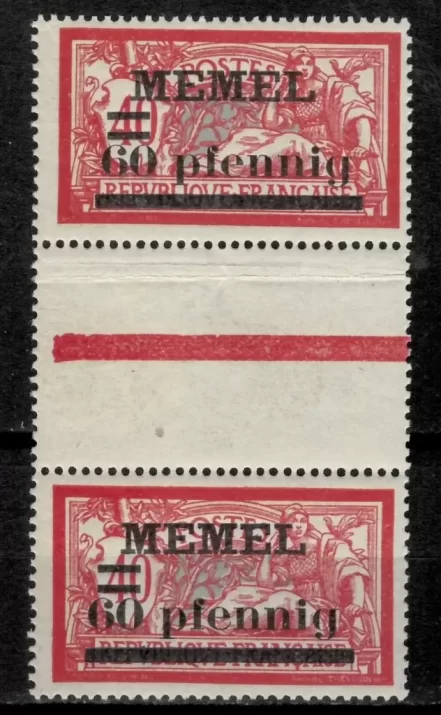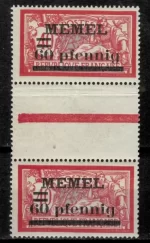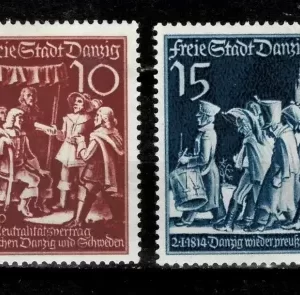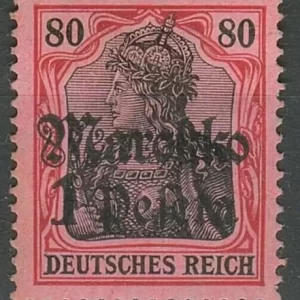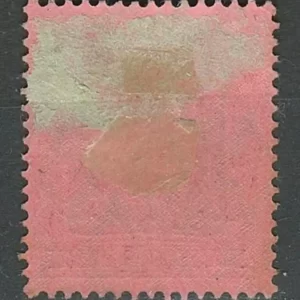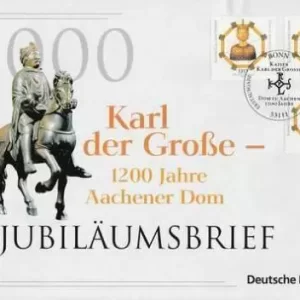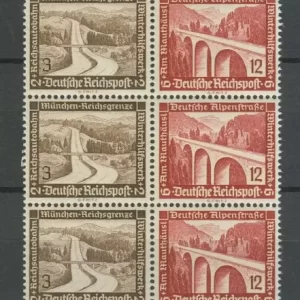Memel / Lithuania year 1920 60pf /40c MNH pair of stamps
The stamps of Memel, also known as Klaipėda, are of significant philatelic interest due to the region’s complex history and political changes. Memel is a seaport and city in Lithuania, located at the mouth of the Curonian Lagoon and the Baltic Sea. Throughout its history, Memel has been part of various political entities, including Germany, Lithuania, and others. Here’s an overview of Memel and Lithuanian stamps:
Memel Stamps (1920-1924)
Provisional Overprints:
- Date of Issue: 1920-1923
- Description: After World War I, Memel became a League of Nations mandate territory under French administration. The existing German stamps were overprinted with “MEMEL” or “MEMELGEBIET” to denote their validity in the region.
- Designs: Overprints on existing German stamps, featuring new inscriptions.
- Denominations: Various, depending on the original German stamps overprinted.
- Significance: These overprints allowed for the continued use of existing German stamps while Memel established its postal administration.
Definitive Issues:
- Date of Issue: 1920-1923
- Description: Memel issued its own stamps separate from those of Germany or Lithuania. These stamps typically featured local motifs, such as the Memel coat of arms or landscapes.
- Designs: Varied designs, often incorporating symbols or scenes relevant to Memel.
- Denominations: Various, covering a range of postal rates.
- Significance: These stamps represented the nascent postal system of Memel as it asserted its autonomy.
Lithuania Stamps (1918-Present)
Pre-Independence Issues:
- Date of Issue: Late 19th century – 1918
- Description: Before gaining independence, Lithuania was part of the Russian Empire and later, during World War I, part of the German Empire. Stamps from this period may bear the names of these empires or local Lithuanian inscriptions.
- Designs: Varied, reflecting the postal needs and artistic styles of the time.
- Denominations: Various, covering postal rates within the respective empires.
- Significance: These stamps represent Lithuania’s pre-independence postal history and its position within larger political entities.
Independence Issues:
- Date of Issue: 1918-1940
- Description: After declaring independence in 1918, Lithuania issued its own stamps. These stamps often featured national symbols, historical figures, and scenes representing Lithuanian culture and heritage.
- Designs: Reflective of Lithuanian national identity, often incorporating patriotic imagery.
- Denominations: Various, covering domestic and international postal rates.
- Significance: These stamps symbolized Lithuania’s assertion of sovereignty and its cultural renaissance during the interwar period.
Collecting Information:
- Philatelic Interest: Stamps from Memel and Lithuania are highly sought after by collectors interested in Baltic and Eastern European philately. Memel stamps, in particular, are prized for their historical significance and the region’s unique political status.
- Thematic Collecting: Collectors interested in specific themes, such as local coats of arms, landscapes, or historical events, may find Memel and Lithuanian stamps particularly appealing.
- Catalog Listings: Memel stamps are listed separately from German stamps in major philatelic catalogs, while Lithuanian stamps are listed under Lithuania. Catalogs such as Scott, Michel, and Stanley Gibbons provide detailed listings and valuations for both.
Historical Context:
- Political Changes: Memel’s history is marked by shifting political allegiances, from German control to French administration to incorporation into Lithuania.
- National Identity: Lithuanian stamps reflect the country’s struggle for independence and its efforts to establish a distinct national identity following centuries of foreign rule.
Legacy:
The stamps of Memel and Lithuania are not only philatelic artifacts but also symbols of the region’s rich history and cultural heritage. Collectors value these stamps for their historical significance, artistic merit, and the stories they tell about the political and social dynamics of the Baltic region.

